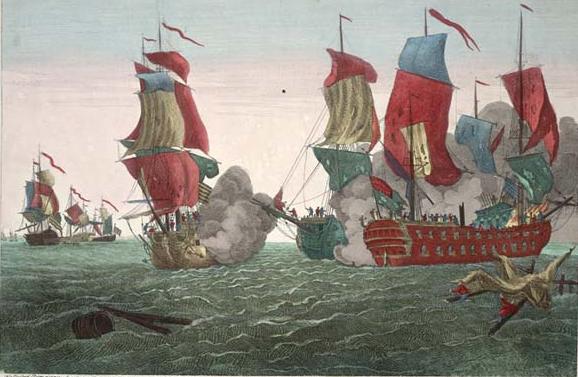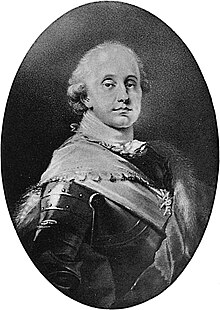
To the British he was “the pirate Paul Jones,” but to us he’s the Father of the American Navy…
* * * *
Speaking of “impudent sly sluts…” (See the last post, “There he goes again.” It cited Robert Louis Stevenson for the allusion, from his book Travels with a Donkey in the Cévennes )
 I recently got another book, John Paul Jones: Sailor, Hero, Father of the American Navy, by Evan Thomas. Near the end it included a slice of American history that I’d never heard before. It told of John Paul Jones – seen at left – and what I’ve come to term “his closest call.”
I recently got another book, John Paul Jones: Sailor, Hero, Father of the American Navy, by Evan Thomas. Near the end it included a slice of American history that I’d never heard before. It told of John Paul Jones – seen at left – and what I’ve come to term “his closest call.”
But first a word of explanation.
I published my last post on May 30, on a proposed kayak trip into the Okefenokee Swamp. Since then I’ve actually done the overnight platform-camping trip to the Canal Run shelter. (A trip that included much planning and preparation, not to mention a full day’s drive down to Valdosta GA, the closest major city to the put-in at Foster State Park.)
I also just got back from a weekend trip to North Carolina. That was for the June 11 high-school graduation of my “favorite grandson named Austin.” (See On “latitude, attitude,” and other life changes,” in my companion blog. That trip also involved a lot of planning and preparation.)
But now I’m back home and ready to go. So, about those “impudent sly sluts…”
Most people know John Paul Jones as the naval hero of the Revolutionary War.
 That included his signal victory over the British man-of-war “HMS Serapis,” in the Battle of Flamborough Head, as seen at right. (At the time, Jones commanded the Bonhomme Richard, which was “originally an East Indiaman.” That is, it was a merchant ship that had been jury rigged into an ad hoc Navy vessel.)
That included his signal victory over the British man-of-war “HMS Serapis,” in the Battle of Flamborough Head, as seen at right. (At the time, Jones commanded the Bonhomme Richard, which was “originally an East Indiaman.” That is, it was a merchant ship that had been jury rigged into an ad hoc Navy vessel.)
Not to mention his having said, “I have not yet begun to fight.” (When asked by the commander of the Serapis if Jones was ready “strike the colours,” that is, to surrender.) Incidentally, Evan Thomas wrote that Jones probably didn’t say that.
On that note, Jones apparently did say – later in the battle – “I may sink, but I’ll be damned if I strike!” And in his official report, Jones merely said that he answered “in the most determined negative.” (An answer that is definitely not as colorful.) But we digress…
What most people don’t know is that in 1787, Jones joined the Russian Navy.
This was after the War, and after futile attempts to collect prize money for the ships he’d captured. (And also in response to his general disgruntlement with the American Congress.) That is, he entered the service of the Empress Catherine II of Russia, who commissioned him a rear admiral. Thus he was known in the Russian Navy as “Kontradmirál Pavel Dzhones.”
That’s when the trouble started. Much as he had been in the American Navy, in the Russian navy Jones was also surrounded by people of far lesser ability and courage. And who were extremely jealous of his ability and courage. (Which happens a lot in history.)
 Those Russian enemies included Prince Charles of Nassau-Siegen. (Seen at left.) He in turn “turned the Russian commander Prince Grigory Potëmkin against Jones.” (And it didn’t help that – like many fighting men – Jones was inapt at “Imperial politics.” That is, political intrigue.)
Those Russian enemies included Prince Charles of Nassau-Siegen. (Seen at left.) He in turn “turned the Russian commander Prince Grigory Potëmkin against Jones.” (And it didn’t help that – like many fighting men – Jones was inapt at “Imperial politics.” That is, political intrigue.)
To cut to the chase, “In April 1789 Jones was arrested and accused of raping a [10]-year-old girl named Katerina Goltzwart.”
Or as Evan Thomas put it, “In early April, St. Petersburg society was shocked, which is to say delighted, by a police report detailing a sordid episode:”
A ten-year-old German girl claimed that she had been raped by Jones. As the little girl described the incident, she had been selling butter in the Admiralty District when she was summoned to an apartment to see a man wearing a white uniform with gold braid and a red ribbon. The man punched her in the jaw, bloodying her mouth. He locked the door, threw off his uniform, and while holding the girl with one hand, threw a mattress on the floor. He pinned her down and penetrated her. Unable to call for help with a handkerchief across her mouth, the girl fainted, woke up, and ran crying into the street.
Moreover, the police had witnesses. One witness was Jones’ manservant, who described “peering through the keyhole to Jones’ bedroom,” and who later found blood on the floor. A midwife gave her expert opinion that the girl had been raped, while a doctor testified that her “child bearing parts were swollen,” and that her lip was cut and her jaw bruised.
Which is why I call this episode “John Paul Jones’ closest call.”
 That is, such an accusation of “child rape” would have been bad enough under American law. But under Russian law, anyone convicted of such rape was “to have his head cut off or be sent to the galleys for the rest of his days.”
That is, such an accusation of “child rape” would have been bad enough under American law. But under Russian law, anyone convicted of such rape was “to have his head cut off or be sent to the galleys for the rest of his days.”
Jones himself was not afraid of death, and indeed it was his courage under fire that made him such a great commander. But had he been convicted as charged, he would have gone down in history as a mere child molester, to be punished as he deserved.
He tried to hire a Russian lawyer, “only to have the lawyer quit his case.” (The Russian government had ordered the lawyer “not to ‘meddle.'”) One of his few friends – the French Count de Segur – visited, only to find him in a suicidal state, his service pistols on a table in front of him. As Jones said, “I would have faced death a thousand times … but today I desire it.”
But slowly, the truth came out. (With a little help from de Segur, “Jones’ last friend in the capital.”)
For one thing, it turned out the girl was 12, not 10. (A minor point, to be sure.) It also turned out both that she’d been “‘selling butter’ for quite a while,” and that “selling butter” was a euphemism for what she had been actually selling.
Then too her customers included that same manservant who’d given damning evidence against Jones. And finally, the girl’s mother admitted that she’d been “given money by a ‘man with decorations’ in return for telling a damaging story about Jones.” (In other words, it was a setup, a “situation in which someone is deliberately put in a bad position or made to look guilty.”)
But enough damage had been done. Jones didn’t have to go through the ordeal of a trial – as illustrated at left – but he was ostracized by Russian society. That included the Empress Catherine, who was “finished with him.” (Notwithstanding the intensity and originality of “her own sexual appetites.”)
And aside from all that, Catherine had hired a number of former British officers, all of whom “refused to serve under the Pirate Jones.” So in the end, in the “late summer of 1789, Jones left Russia, still resplendent in his beribboned white uniform, but shunned and disgraced.”
From which we can glean at least two key object lessons. One is that many of our hardest-fighting heroes – like John Paul Jones – also have a “penchant for the ladies.” (Which can ofttimes be their undoing in civilian life.) Yet another is that – as a nation – we tend to tear down the very heroes that we build up. (See e.g. Why Do We Build-Up & Then Tear-Down Our Heroes?)
In the case of John Paul Jones, it took more than a century after he died – not until July 1905 – that his body was finally returned to his adopted homeland – the one that he’d fought so hard for – and given a decent burial. (In Annapolis, site of the Naval Academy.)
And then only because “Teddy Roosevelt needed a hero…”
* * * *
The upper image is courtesy of John Paul Jones – Wikipedia, the free encyclopedia.
The caption for the upper image: “Paul Jones the Pirate,’ British caricature.”
(Note that a caricature is a “rendered image showing the features of its subject in a simplified or exaggerated way… In literature, a caricature is a description of a person using exaggeration of some characteristics and oversimplification of others… Caricatures can be insulting or complimentary and can serve a political purpose…”)
 The Wikipedia article also included the image at left, with the caption: “John Paul Jones and John Barry, honored on U.S. Postage, Navy Issue of 1937.” Note that Barry is one of at least three men – including Jones – in the running for the title of “Father of the American Navy.” See for example Commodore John Barry, Father of the American Navy, and also Joshua Humphreys, “Father of the American Navy.”
The Wikipedia article also included the image at left, with the caption: “John Paul Jones and John Barry, honored on U.S. Postage, Navy Issue of 1937.” Note that Barry is one of at least three men – including Jones – in the running for the title of “Father of the American Navy.” See for example Commodore John Barry, Father of the American Navy, and also Joshua Humphreys, “Father of the American Navy.”
Re: “Impudent, sly sluts.” See also Donkey travel – and sluts, in my companion blog.
See also Definition of slut by The Free Dictionary. Although the term – today – has come to mean almost exclusively either a prostitute or a woman “considered to be sexually promiscuous,” that wasn’t always the case. For example, in Travels with a Donkey in the Cévennes, Stevenson applied the term to two young girls who were simply being mischievous and/or “pains.” For another take, see Slut-shaming – Wikipedia, on the form of behavior modification in which a social stigma is “applied to people, especially women and girls, who are perceived to violate traditional expectations for sexual behaviors.”
Re Evan Thomas. See also Wikipedia. The quoted portions from Thomas’ Jones: Sailor, Hero (etc.) are from the 2004 Simon and Schuster paperback version, at pages 297-99.)
The oil portrait of Jones is also courtesy of the Wikipedia article on Jones. The caption: “A 1781 painting of John Paul Jones by Charles Willson Peale.”
Re: “general disgruntlement with the American Congress.” Go figure!
Re: Jones’ political enemies in the Russian Navy. See Wikipedia:
As a rear admiral[, Jones] … took part in the naval campaign in the Dnieper-Bug Liman … against the Turks, in concert with the Dnieper Flotilla commanded by Prince Charles of Nassau-Siegen. Jones (and Nassau-Siegen) repulsed the Ottoman forces … but the jealous intrigues of Nassau-Siegen (and perhaps Jones’s own inaptitude for Imperial politics) turned the Russian commander Prince Grigory Potëmkin against Jones and he was recalled to St. Petersburg for the pretended purpose of being transferred to a command in the North Sea.
Re: political intrigue. See also Byzantinism – Wikipedia.
The galley-slave image is courtesy of Ben-Hur (1959) – IMDb. See also Galley slave – Wikipedia.
Re: Jones’ defense against the rape charge. As Wikipedia noted:
… the Count de Segur, the French representative at the Russian court (and also Jones’ last friend in the capital), conducted his own personal investigation into the matter and was able to convince Potëmkin that the girl had not been raped and that Jones had been accused by Prince de Nassau-Siegen for his own purposes; Jones, however, admitted to prosecutors that he had “often frolicked” with the girl “for a small cash payment,” only denying that he had deprived her of her virginity.
Note that St. Petersburg [was] the capital of Russia between 1712 and 1918.
The lower image is courtesy of virtualtourist.com, “United States Naval Academy: reviews, photos.”
In John Paul Jones, Evan Thomas described the return of Jones’ body from France at pages 3 and 4 of his Introduction. “Jones had died, alone and forgotten, in Paris in 1792.” His body had lain “in a graveyard so obscure that it had been paved over.” It had taken months for the American ambassador to find the burial site, “beneath a laundry on the outskirts of the city.”
On page 3, Thomas described the honor guard, in Paris, of 500 American sailors, all picked for their height – over six feet – and “manly good looks.” In response to the American honor guard marching down the Champs Elysees – wrote Thomas – “‘Quels beaux garcons!’ whispered the French ladies in the vast, cheering crowd.” (The French translates roughly to “Who are those fine-looking studs?”)
As to “Teddy Roosevelt need[ing] a hero,” Jones wrote that Roosevelt wanted to make the United States a great naval power, and so wanted to “celebrate Jones’ legacy with appropriate pomp.” He therefore decreed that every “officer in our navy should know by heart the deeds of John Paul Jones,” and that all Naval Academy cadets must memorize jones’ “pronouncements on the correct training and proper manners of an officer and a gentleman.” Then there was the tomb itself:
Jones was laid to his final rest in a marble sarcophagus modeled after Napoleon’s own crypt. “He gave our Navy,” reads the inscription on the tomb, “its earliest traditions of heroism and victory…” How Jones would have loved it.
And finally, as to Jones having a “penchant for the ladies:” At page 298 Thomas wrote of Jones’ response – in part – to the charge of rape, “I love women, I confess, and the pleasures that one only obtains from that sex; but to get such things by force is horrible to me.”

 Next up is a family trip north: Three cars, carrying five adults and seven younger folk, ranging in age from 10 to 22. Among other places, we’ll be visiting Valley Forge, the Liberty Bell and Philadelphia in general. (Seen at right, back in the 1910s.) Last but not least we’ll see Hershey, PA … “The Sweetest Place On Earth.”
Next up is a family trip north: Three cars, carrying five adults and seven younger folk, ranging in age from 10 to 22. Among other places, we’ll be visiting Valley Forge, the Liberty Bell and Philadelphia in general. (Seen at right, back in the 1910s.) Last but not least we’ll see Hershey, PA … “The Sweetest Place On Earth.”


 I recently got another book,
I recently got another book,  That included his signal victory over the British
That included his signal victory over the British  Those Russian enemies included Prince
Those Russian enemies included Prince  That is, such an accusation of “child rape” would have been bad enough under American law. But under Russian law, anyone convicted of such rape was “to have his head cut off or be sent to the galleys for the rest of his days.”
That is, such an accusation of “child rape” would have been bad enough under American law. But under Russian law, anyone convicted of such rape was “to have his head cut off or be sent to the galleys for the rest of his days.” The Wikipedia article also included the image at left, with the caption: “John Paul Jones and John Barry, honored on U.S. Postage, Navy Issue of 1937.” Note that Barry is one of at least three men – including Jones –
The Wikipedia article also included the image at left, with the caption: “John Paul Jones and John Barry, honored on U.S. Postage, Navy Issue of 1937.” Note that Barry is one of at least three men – including Jones –